Table of contents:
1. The concept of the sustainable town/city
2. From the Charter of Athens to the
Charter of Aalborg
3. From hygienism to the sustainable
town/city
4. New constraints: the urban microclimate,
energy infrastructures, recyling
5. Present experience/case studies
6. Difficulties in application of sustainable
urban development
7. Study in depth
1. The concept of the sustainable
town/city - introduction
“Why should we accept the
idea of an economy in full expansion as a way of salvation when
in reality what we need is a balanced economy which places the necessities
of life before profit, prestige or power” Lewis Mumford
European - and world - history of
the ideal city is a long one, a permanent quest by humanity for
a built environment most adapted to the needs of our civilisations.
Study
in depth: La cité idéale en occident à travers
l'histoire (The ideal occidental city through history) >>>
Today, the concept of the sustainable
town/city which a few years ago was attributed to the aspirations
of an environmentalist’s utopia is starting to stimulate the
urban debate.
The concept made one of its first appearances in
the UNESCO programme ‘Man and Biosphere’(1988). However,
it is primarily within the context of the Rio Summit (1992), that
this concept starts to attract attention. The European Campaign
for sustainable towns & cities initiated in the Danish town
of Aalborg (1994), polarises awareness in European towns & cities
by offering frameworks for meeting, reflection and exchange encouraging
the implementation of local strategies for sustainable development.
Sustainable development starts to be integrated
into policy-making, urban transport, and projects of urban planning.
Judicial and statutory frameworks are put in place but their impact
is limited. In the field, initiatives for sustainable development
often suffer from a lack of support, tools or efficient leverage.
Despite these limits an urban
vision is emerging that is not lacking in coherence.
A priority of the sustainable town/city is to instigate
a new dialogue between urban habitat and terrestrial habitat. A
local/global relationship is woven, differing to that fostered by
insertion into world economic competition.

Wind, waves and vegetation: the planet is not inanimate. It is a
living organism…every element of the planet’s biosphere
is a constantly renewed surface / Ref. "Cities for a small
planet" / Richard Rogers / 1997

Evidence from space of man’s physical impact on the planet’s
surface. We are now literally shaping the face of the planet. With
20 million residents, the metropolitan area of Tokyo forms the world’s
largest city / Ref. Science Photo Library.
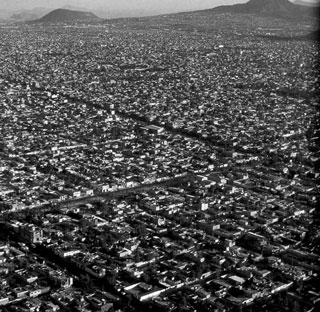
The Endless City: Mexico City’s population has grown from
100,000 to 20 million in less than a hundred years. People continue
to pour in from the countryside at the rate of 80,000 per month
/ Photo: Stuart Franklin

The steepest growth rate has been in cities. In the 1950’s
29% of the world’s population was urban. In 1965 it was 36%,
in 1990 50%, and by 2025 it could be at least 60%. / Ref. "Cities
for a small planet" / Richard Rogers / 1997
A second stake is the anchoring of the ecological
question to the social question, on the one hand because today the
environment is a question of society: political, urban, industrial
and agricultural choices, and on the other because social inequality
is often intensified by ecological inequalities. Granting that the
body of society is subjected to a number of risks, urban cartography
clearly shows parallels between zones exposed to high pollution
levels or more localised risks and territories that are socially
weakened.
A third stake is democratic: sustainable development
is a good support with which to open up public debate on the validity
of the present management of land – that of considering land
as a commodity. Land speculation often has more impact on urban
planning than projects established according to environmental imperatives
and the real needs of the population. A fundamental review of the
way land is managed seems indispensable in order to allocate real
power to local communities and local authorities to forward a more
ecological and equitable built environment.
The ambition and complexity of this programme invites
a certain amount of reserve when attempting to define a sustainable
environment because there are no clear-cut answers to the questions,
challenges and contradictions highlighted by sustainable development.
Furthermore, the diversity of local approaches is not easily definable.
Whilst the stakes for a sustainable town/city hold some common ground:
policies are contextual, adjusted to local cultures, local ecology
and territorial specificities. The notion of the sustainable town/city
is constructed within both a local and global context: between an
imperative of respecting local diversity and the necessity of adhering
to the vision of urban sustainability.
2. From the Charter of Athens to the Charter of Aalborg
The assertion of sustainable development
in the urban landscape engages with a broad questioning of modern
urban planning born in the wake of the Modern Movement in the 1930’s.
In parallel a sort of hygienism comes into play beneath the surface.

Ref.: "Befreites
Wohnen, 85 Bilder, erläutert von S.Giedion"
Study
in depth: La ville moderne / Les visions du C.I.A.M. 1930 / Existenzminimum,
hygiène et santé...
(The modern town/the visions of C.I.A.M. 1930 / Existenzminimum,
hygiene and health…) >>>
The dysfunctions induced by the model of the Charter
of Athens and its applications are at the heart of 'The Green Book
on the Urban Environment', which marks a turning point in 1990 in
the outlook towards the urban environment by the European Commission.
The European campaign for sustainable towns & cities in 1994
concludes with the drafting of the Charter of Aalborg.
Sixty years or so separate the elaboration of the
Charter of Aalborg with that of the Charter of Athens. This new
Charter advocates urban policies that integrate the impact of short
and long-term development on the environment and questions some
founding principles of the Charter of Athens.

Ref.: Revue "Urbanisme",
N° 330
The principle of the ‘clean sweep’
of the Charter of Athens is contested and instead the value placed
upon patrimony and heritage is enhanced. The patrimonial and cultural
dimension of the town/city is imposed as a central element of its
planning.

Ref.: La ville de trois millions d'habitants
/ Le Corbusier (1922) / Virgilio Vercelloni, "La cité
idéale en occident"
(Town of 3 million inhabitants / Le Corbusier
(1922) / Virgilio Vercelloni, “The ideal city in the Occident”)
The removal of modern architecture from context,
fed by industrial standardization and the modern international style,
gives way to concern over the adaptation to milieu and improvement
of local identities. This adaptation can take place through looking
to the past and an over indulgence of the neo-vernacular register
(dreaded by the Modernists) but can lend itself equally to a very
contemporary architecture capable of chiming with the site or landscape,
the patrimony, light or vegetation.
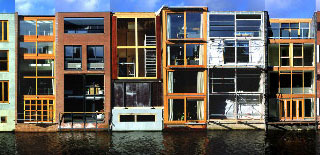
Borneo Sporenburg, Amsterdam, Netherlands
‘Zoning’, a key term in the Charter
of Athens is substituted by research into ‘mixed-use nodes’
with potential to enrich an urban landscape through integral use
of space, reducing journey requirements, through proximity of activities.

Compact mixed-use nodes reduce journey requirements
and create lively sustainable neighbourhoods / Ref. "Cities
for a small planet" / Richard Rogers / 1997
The paradigm of traffic flow and
fluidity implied by separating traffic according to modes of transport
opens up the debate about traffic in towns & cities.

Ref.: "L'urbanisme contemporain- Des
origines à la Charte d'Athènes"
(“Contemporary urban planning” Origins of the Charter
of Athens)

Ref.: "L'urbanisme contemporain- Des
origines à la Charte d'Athènes"
(“Contemporary urban planning” Origins of the Charter
of Athens)
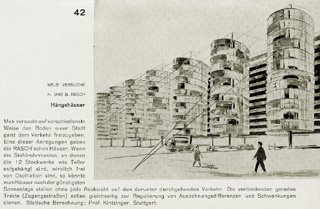
Ref.: "Befreites
Wohnen, 85 Bilder, erläutert von S.Giedion"
The re-appropriation of the highway
by all modes of transport becomes a strategy to moderate automobile
traffic and regain public space.

Cars, cars, cars: By the middle of the twentieth centry, there were
2.6 billion people on earth and 50 million cars. In the last fifty
years the global population has doubled while the number of cars
has increased tenfold. In the next twenty-five years the world population
of cars is expected to reach a billion. Mass motorisation has arrived
and is set to spread to every city in this world / Ref. "Cities
for a small planet" / Richard Rogers / 1997
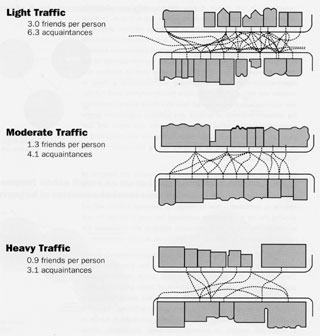
Friends or traffic ? A "Pedestrian
traffic flow Research" in San Francisco confirms the simply
reality that urban traffic undermines a street's sense of community.
In a single neighbourhood tree streets with different intensities
of traffic are compared. As traffic increases so casual visits to
neighbours decline. Traffic is a signific cause of urban alienation.
/ Ref. "Cities for a small planet" / Richard Rogers /
1997
Short cut,
go to chapter: La mobilité…( Mobility …)>>>
Instead of rationalist urban planning by experts, the Aalborg Charter
promotes a policy based on partnership and participation of the
town/city itself. New ways of working together are advocated, which
should involve a number of the population interested in the theme.
Sustainable development confronts the decision-makers with the complexity
of the decision; revealing to them what they are unable to control.
Passing through this phase of uncertainty and collaboration means
that one accepts that the answers that one held no longer function
in an optimum manner.
| The Charter of Athens 1933 |
The Charter of Aalborg 1934 |
| Principal of the ‘clean sweep’ |
Patrimonial attitude (heritage)
Improvement of what already exists
|
| Disregard of architecture in relation to surrounding
context (historic, geographic, cultural, ecological)
International style
|
Insertion of construction/building development
in a multi-dimensional environment
|
| Zoning |
Mixed-use function and cross disciplinary politics
|
| Facilitation of traffic flow
Separation of different modes of transport
|
Constraints to reduce traffic
Re-appropriation of public highways by all modes of transport
|
| Urban planning by experts
Geometricalisation and rationalisation of the town/city
|
Participatory urban planning
Singularity of solutions/answers
|
Contradicting points of view between the Charter
of Athens and Aalborg/ Cyria Emelianoff ‘La notion de la ville
durable dans le contexte europeen: quelques elements de cadrage”
(“The notion of the sustainable town/city in a European context:
some framing elements”) in ‘Enjeux et politiques de
l’environment’, cahier francais no.306, janvier-fevrier
2002
3. From Hygienism to the sustainable town/city
Comparative interplay can be observed
between the policies of hygiene and sustainable development. In
the case of hygiene, it is the excessive policy operating in its
name rather than its basic approach that may be called into question.
Numerous environmental problems are not visible or are not matters
directly relating to hygiene. Carbon dioxide is colourless and odourless,
pesticides are scarcely detectable, chemical products which can
interfere with hormonal systems were (yesterday) considered inoffensive.
At the other end of the scale, global warming, over-fishing, soil
erosion, biodiversity, desertification and deforestation have little
to do with hygiene.
Questions to do with environmentalist hygiene have
widely shifting emphases.
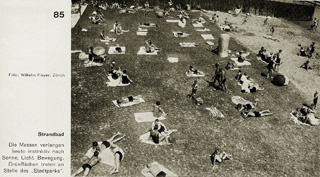
Ref.: "Befreites Wohnen, 85 Bilder, erläutert
von S.Giedion"
Study
in depth: La ville moderne / Les visions du C.I.A.M. 1930 / Existenzminimum,
hygiène et santé...
(The modern town/the visions of C.I.A.M. 1930 / Existenzminimum,
hygiene and health…) >>>
The race for cleanliness, and against pollution,
the opening of an office for complaints, square meters of green
space do not make up a policy of sustainable development.
In the urban landscape and in the Occidental context,
urban sustainable practices go as far as overturning the political
principles conducted in the X1X century. Necessary in their day,
as was the response of modern urban planning, they no longer correspond
to present imperatives.
Hygienists of the X1X century worked to increase
space within towns/cities creating wide avenues. They encouraged
‘zoning’ that is the separation of functions/activities
and populations.
Policies of sustainable urban development take
opposing action to this approach. The extension of city limits advocated
by the Moderns following the hygienist movement is replaced by the
opposite concern of containing urbanization, braking growing consumption
of space, infrastructures and energy. Traffic is no long a remedy
to the problems of hygiene but on the contrary is one of the main
factors of pollution in a town/city. Policies for urban spatial
planning have been so successful that ways of urban ‘tightening’
are necessary in order to control or even simply manage mobility.
The X1X century strove to make urban ground impermeable
and to cover canals - to dry out the towns/cities in order to curb
putrefaction transmitted by the ground and water. Water is being
found to have its attractions however, in today’s urban environment
for its recreational, ecological, aesthetic and refreshing qualities
There is a revival of the waterways networks in
towns/cities as rivers and canals covered over in the XX century
are restored to the open air, pathways along river/canal banks are
reopened, wetlands in and around urban areas are restored and abandoned
fluvial ports are refurbished.
The hygenic propensity towards expansion of green
space is equally replaced by more qualitative visions, concerned
with vegetation and landscape composition, continuity or ecological
corridors to favour biodiversity or different ways for use of nature
in an urban environment.
| Hygienist policies |
The policies of sustainable development |
Creating urban spaces (purification, deconta-
mination, improvement, airing)
|
Concentration/compacting to curb urban
sprawl
|
| Drying-out of towns/cities:
- covering up canals/waterways
- containment of rivers
- abandoning wetlands/marshes near urban areas
|
Rehabilitation of wetlands:
- project of reopening canals
- refurbishment of fluvial ports
- restoration of marshes near urban areas |
Making urban ground impermeable
Laying tarmacadam
|
Making urban ground permeable |
| Burying the water-cycle |
Management of rainwater
Lagooning
|
| Policy of expansion of green spaces |
Siting green spaces beside waterways
Policy of continuity of green spaces
|
A progressive departure from
hygienism / Cyria Emelianoff ‘La notion de la ville durable
dans le contexte europeen: quelques elements de cadrage” (“The
notion of the sustainable town/city in a European context: some
framing elements”) in ‘Enjeux et politiques de l’environment’,
cahier francais no.306, janvier-fevrier 2002
4. New Constraints: The urban microclimate,
energy infrastructures, recycling…
Last but not least
we are confronted by new phenomena such as problems of flooding
and the limits of the capacity of purification plants due to the
impermeable nature of urban ground and the heat island effect of
urban heat generated by the process of urbanization associating
heat sources and storing capacity too great in relation to efficiency
of natural mechanisms of cooling available. The transformation of
land also implies control of modification of natural energy cycles.
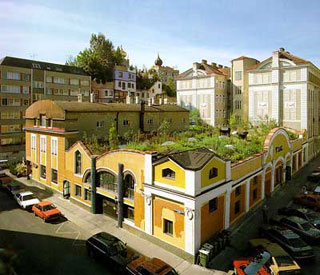
Photo: Kalke Village shopping complex green
roof, Vienna
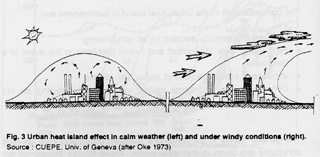
Heat-Island effect
Short cut,
go to chapter: Microclimat urbain...(urban microclimate…)>>>
Recycling in all imaginable ways is equally desirable:
natural treatment and filtering of water, reuse, recycling or downcycling
of construction materials and all ‘consumable’ products
in general.

Water recycling management: Domestic water
is filtered and reused for irrigation / Ref. "Cities for a
small planet" / Richard Rogers / 1997

Linear metabolism cities consume and pollute
at a high rate / Ref. "Cities for a small planet" / Richard
Rogers / 1997

Circular metabolism cities minimise new inputs
and maximate recycling / Ref. "Cities for a small planet"
/ Richard Rogers / 1997
Revalorisation of the energy value of domestic
waste or the production of biogas from green waste allows for electricity
production or covers heating needs of buildings through long distance
heating networks.

The conventional system / remote power generation
/ Ref. "Cities for a small planet" / Richard Rogers /
1997

The compact model / local power generation
and waste recycling / City waste should
be seen as a resource to be mined. / Ref. "Cities for a small
planet" / Richard Rogers / 1997
Short
cut, go to chapter: Infrastructures de l'énergie... (Energy
infrastructures…)>>>
Solar access, already considered important by the
Modern Movement motivated by research into well-being and public
health, takes on significance today which is more closely associated
with questions of energy independence and atmospheric pollution.
Hence a search for urban structures, which exploit the advantages
of passive solar energy through carefully orientated glass facades
and the use of roofing for the installation of thermal or photovoltaic
solar collectors.
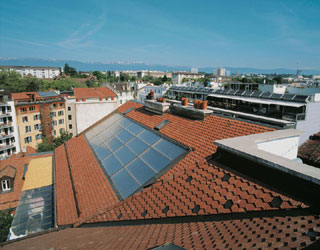
Photo: thermal solar collectors, ilôt
13, Geneva, Switzerland
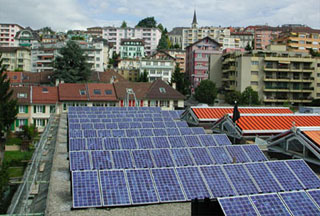
Photo: Solstis, Etablissement Cantonal d’Assurances
(ECA), Lausanne
Short
cut, go to chapter: Infrastructures de l'énergie... (Energy
infrastructures…)>>>
Another challenge of the XX1 century is the integration
of windparks in the landscape...

Photo: Danemark

Photo: Windpark in Palm Springs (California)

Photo: Windpark in Tehachapi, USA
5. Present experience/case studies...
Today, existing trials for the sustainable town/city
are rather marginal but as they are increased, they demonstrate
a diversity that reveals quite different approaches from which the
concept can be addressed. In spite of contrasting appearances, which
may often reflect either regional or cultural particularities, these
trials can serve as examples for the whole of the European territory.
Eurotechnics, ecolabels
and ecobudgets
An initial approach targets ecotechnics and the ecological labelling
of products by businesses or even local authorities. This approach
lays out an ecosystemic conception of the town/city: multiplying
instruments of evaluation, elaborating an ecobudget, putting a system
of environmental management into place and aspiring to label products
for ‘good’ conduct in relation to water, air and different
pollutants. Ecological clauses are introduced into commercial contracts
and buying ‘green’ encourages businesses to adopt improvement/
‘reconversion’ strategies favourable to the environment.
Restrictions and taxation laws that favour ecology are main levers
towards the development of environmental techniques in industry
and, for example, marked advances in the sphere of ‘environmentally
friendly’ buildings. At the same time, ‘green’
consumerism will assert itself with the growth of labelled products
and environmental competition.
Planning the ‘compact’
town
This relates to the containment of urban and suburban expansion
through favouring density – compact mixed-use nodes with pedestrian
zones and restricted speed traffic zones, which improve the quality
of life in densely populated areas. Several planning axes can be
distinguished: planning public transport in conjunction with home
and workplace, organising public transport (railways) on a regional
and urban scale where urban concentration is in the vicinity of
public transport infrastructures and a compact organisation of the
town/city (linear, unipolar or polycentric), which aims to limit
travel. The installation of ‘green’ frameworks channel
urbanization whilst providing ecological and recreational resources.

Compact nodes linked by mass-transit systems
can be arranged in response to local constraints / Ref. "Cities
for a small planet" / Richard Rogers / 1997
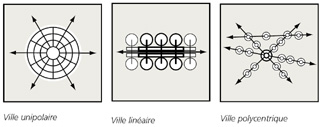
Unipolar, linear and polycentric towns/cities
/ Ref.: "La Ville dense et durable. Un modele europeen pour
la ville ?" in "Vues sur la ville - Observatoire universitaire
de la ville et du développement durable" / Béatrice
Bochet, Jean-Bernard Gay , Giuseppe Pini / octobre 2002 and octobre
2003
On an infra-urban level the development of new
sustainable neighbourhoods, which have had some success in Germany
and other countries, can be observed. Built on disused docklands,
military or industrial wastelands they constitute both a ‘showcase’
and evidence of sustainable urban planning. They are most often
integrated into a sustainable development policy carried out on
the level of agglomeration. These planning processes are based on
the search for the ‘compact’ town - less energy consuming
and economical in space. The concept of the sustainable town/city
is often translated into ‘compact town/city’ or ‘a
town/city of short distances’.

Photo: Stadtteil Freiburg-Vauban, Germany

Photo: Quartier Kronsberg, Hannover, Germany
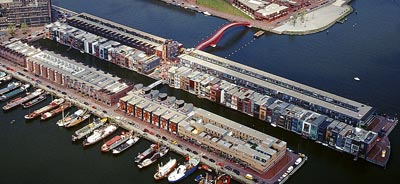
Photo: Borneo Sporenburg, Amsterdam, Netherlands,
a new prototype for low-rice high-density housing in Amsterdam's
docks
Social and Ecological
rehabilitation
Another approach is to grant social and ecological refurbishment
programmes to old buildings, small blocks or larger neighbourhoods.
The permanent reuse of places and of the urban fabric is an acceptance
of the sustainable town/city and its possibilities for self-renewal.
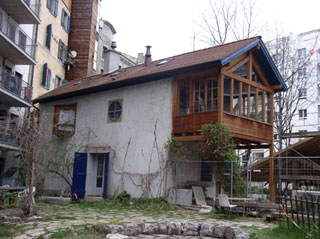
Photo: Rehabilitation of ‘ilot’
(‘block’)13, Geneva, Switzerland
The quality of the urban
landscape
This kind of project relies on the inclination of the urban landscape
and its qualities. The urban environment is perceived in its architectural
and aesthetic dimension and appreciated in association with the
quality of its open spaces. This approach puts an emphasis on sensitive
relationships, both social and cultural that are established between
the inhabitants and their town/city.
6. Difficulties in application of
sustainable urban development
The ease with which different strategies
may achieve a sustainable built environment and respect for the
environment as previously discussed is closely associated with management
of land. It is no accident that the great majority of sustainable
neighbourhood experiences are situated within contexts where public
authorities have an important say over a given territory. A broadening
of municipal power appears to be an essential condition for planning
and especially setting in motion the elements that constitute the
sustainable town/city without economic or speculative constraints.
Land, a commodity: the adverse effects
of mismanagement of land
At present totally reckless, irresponsible management of land allows
and imposes excessive speculation. The prices of the urban built
environment (flats, offices, commercial surfaces and other) increase
and the result of this is to reserve the latter for wealthy inhabitants
and businesses, creating social segregation and urban sprawl. The
town/city dweller no longer chooses his accommodation with a view
to practical criteria such as proximity between workplace and home
or between family and friends, but only in accordance with availability
of affordable accommodation.
Setting urban planning
in motion: difficult without true control of land by public authorities
It should be highlighted today, that in spite of the awareness that
a policy of high-density housing/building is indispensable, land
management practices, which consider land as a commodity jeopardise
the establishment of measures in favour of this objective. Only
strong policies tending towards at least partial state control over
land that is still available (agricultural land not permitted for
development) and policies enabling public authorities to acquire
land and buildings still available on the market, can guarantee
the setting in motion of building development that respects the
environment and is equitable for the population in the medium or
long term.
Ideas for a more reasonable
management of land: the example of Holland
Management of land such as practiced in Holland, for example, involves
the intervention of public authorities in relation to land ownership
(policies of acquisition, leaseholds etc.) favouring and greatly
simplifying the process of planning/management of land whilst remaining
compatible with a market economy engaged with commodities other
than land. These countries gain enormous advantages, and in the
long term, through being able to offer their citizens a well thought-out,
affordable built environment that is much more easily adaptable
to demographic, social and mobility needs, and last but not least
to environmental imperatives.
It is perhaps apt to remind those tempted to think
that this type of ‘collective’ land management is of
communist/marxist ideology, that many reputable economists (including
several Nobel prize-winners) speak very highly of the considerable
advantages to be had from a more collective management of land and
warn of the risks which are run by a world economy based more and
more on money generated by the speculative bubble (reminder: the
collapse of the property market in Japan, where property values
fell by 40%, plunging the country into a ten-year recession from
which it is emerging painfully today).
The creation of sustainable urban development
is hardly dissociable from a broadening of public powers and by
fundamental questioning of the policy of management of land, which
still views land as a commodity.
Peter Haefeli, architect, scientific
collaborator at CUEPE (Centre universitaire d’etude des problems
de l’energie) Geneva University
Study
in depth: Politique de gestion du territoire … (the policy
of land management…)>>>
7. Study in depth
CYRIA_EMELIANOFF_Ville_durable_dans_le_contexte_europeen.pdf
Aalborg_charter_english.pdf
Aalborg_charter_french.pdf
Aalborg_charter_german.pdf
Aalborg_charter_italian.pdf
New_Athen_charter_2003_english.pdf
New_Athen_charter_2003_french.pdf
BOCHET_GAY_PINI_La_Ville_dense_et_durable_Un_modele_europeen_pour_la_ville.pdf
VUES_Ville_durable_et_mobilite.pdf
http://www.unil.ch/igul
http://www.unil.ch/igul/page14548.html
NZZ_Holland_Triumph_der_kunstlichen_Natur.pdf
NZZ_Wir_gestalten_die_Niederlande_neu.pdf
EUROPE_Sustainable_local_energy_policy_in_european_towns.pdf
|
![]()